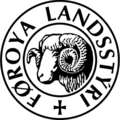- Coat of arms of the Faroe Islands
-
The coat of arms of the Faroe Islands first appears in one of the mediæval chairs in Kirkjubøur from around the 15th century. It depicts a Ram (Faroese: Veðrur) on a shield. Later uses show a Ram in a seal used by the Løgrættumenn, members of the Old Faroese law Court, the Løgting.
The coat of arms went out of use when the Løgting was abolished in 1816. After the Løgting was reestablished in 1852 and even when the Faroe Islands were effectively outside direct Danish rule during the British occupation in World War II the coat of arms was not used.
After the Home Rule Act came into force in 1948 the coat of arms came into use again. Not by the Løgting (Parliament) but by the Landsstýri (Government). The old title Løgmaður had been reestablished, but this time as the leader of the government. The coat of arms followed him.
On 1 April 2004, the Prime Minister's Office announced that from then on the Prime Minister and the Prime Minister's Office would use a new version of the coat of arms. This new one was based on the original from the chairs from Kirkjubøur. The colours were inspired from the Faroese flag Merkið and golden yellow was added. The new coat of arms depicts a ram on a blue shield ready to defend. It can be used by Cabinet Ministries and by official Faroese representatives, though some still use the old symbol.
-
Coat of arms at the Faroese Embassy in Copenhagen
 Faroe Islands topics
Faroe Islands topicsIslands History, politics
and economyTimeline · Færeyinga Saga · Parliament · Folketing · Prime Minister · Political parties · Economic history · Companies · Currency · Taxation · LGBT rightsGeography and
demographicsCulture Art · Literature · Music · Cinema · Sport · Media · Whaling · Ólavsøka · Merkið (flag) · Tú alfagra land mítt · Coat of arms · CuisineCoats of arms of Europe Sovereign
states- Albania
- Andorra
- Armenia
- Austria
- Azerbaijan
- Belarus
- Belgium
- Bosnia and Herzegovina
- Bulgaria
- Croatia
- Cyprus
- Czech Republic
- Denmark
- Estonia
- Finland
- France
- Georgia
- Germany
- Greece
- Hungary
- Iceland
- Ireland
- Italy
- Kazakhstan
- Latvia
- Liechtenstein
- Lithuania
- Luxembourg
- Macedonia
- Malta
- Moldova
- Monaco
- Montenegro
- Netherlands
- Norway
- Poland
- Portugal
- Romania
- Russia
- San Marino
- Serbia
- Slovakia
- Slovenia
- Spain
- Sweden
- Switzerland
- Turkey
- Ukraine
- United Kingdom
- (England
- Northern Ireland
- Scotland
- Wales)
- Vatican City
States with limited
recognition- Abkhazia
- Kosovo
- Nagorno-Karabakh
- Northern Cyprus
- South Ossetia
- Transnistria
Dependencies
and other territories- Åland
- Faroe Islands
- Gibraltar
- Guernsey
- Jan Mayen
- Jersey
- Isle of Man
- Svalbard
Other entities Categories:- National symbols of the Faroe Islands
- National coats of arms
Wikimedia Foundation. 2010.



